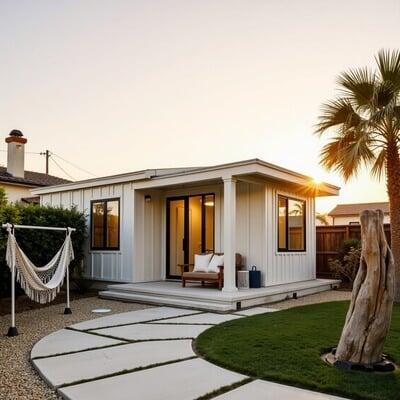| Table of Content |
| 1. What is an ADU? |
2. Why Build an ADU in Bay Area? |
| 3. Types of ADUs |
| 4. Bay Area ADU Laws and Regulations |
| 5. ADU Design and Planning |
| 6. Permitting Process for ADUs |
| 7. Construction Timeline |
| 8. Costs Associated with Building an ADU |
| 9. Financing Your ADU Project |
| 10. Hiring Professionals for Your ADU |
| 11. Common Challenges and How to Overcome Them |
| 12. Conclusion |
| 13 FAQ |

1. What Is an ADU?
An Accessory Dwelling Unit (ADU) is a secondary residential structure located on the same lot as a primary home. These can be standalone homes, attached additions, garage conversions, or internal modifications (like a basement apartment).
Types include:
Detached ADUs
Attached ADUs
Junior ADUs (JADUs)
Garage Conversions
Interior Conversions (basements, attics)
2. Why Build an ADU in Bay Area?
The Bay Area faces a housing affordability crisis, making ADUs a popular solution. Here’s why homeowners choose to build them:
Rental income stream
Housing for family members
Increased property value
Flexibility in use (guest house, office, Airbnb)
Reduced environmental footprint
3. Types of ADUs
| Type | Description |
| Detached ADU | Built as a separate structure on the property |
| Attached ADU | Shares at least one wall with the main home |
| Garage Conversion | Converts a garage into livable space |
| Junior ADU (JADU) | Max 500 sq. ft. within the existing house |
| Basement ADU | Converts the basement into an independent unit |
4. Bay Area ADU Laws and Regulations
Bay Area cities like San Jose, San Francisco, Fremont, and Santa Clara follow California’s updated ADU laws:
✅ Statewide ADU Law Highlights:
One ADU + One JADU allowed per lot
No minimum lot size restrictions
4 ft side and rear setbacks
No impact fees for ADUs under 750 sq. ft.
60-day permit approval mandate
Parking requirements waived under certain conditions
Cities may impose local design standards, so always verify with your city’s planning department.
5. ADU Design and Planning
Before submitting your permit:
Get a site assessment
Hire an architect or ADU designer
Consider privacy, natural lighting, and lot coverage
Include access paths, entryways, and utility connections
Follow ADA guidelines (optional but useful for aging in place)
Using a pre-approved ADU plan can expedite permitting.
6. Permitting Process for ADUs
🔄 Steps to Obtain an ADU Permit in Bay Area:
Feasibility Study – Determine what’s legally possible on your lot.
ADU Design & Drafting – Work with professionals.
Submit Application – Include site plan, floor plan, elevation, and structural details.
Permit Review – Zoning, building, and fire departments review.
Permit Issuance – Upon approval, permits are granted to begin construction.
Use local ADU consultants to navigate the California ADU permit application process efficiently.
7. Construction Timeline
| Phase | Duration |
| Design & Planning | 1–2 months |
| Permitting | 1–2 months |
| Construction | 4–8 months |
Total Estimated Time: 6 to 12 months
8. Costs Associated with Building an ADU
| ADU Type | Cost Range |
| Garage Conversion | $80,000–$150,000 |
| Detached ADU | $150,000–$400,000 |
| Attached ADU | $120,000–$250,000 |
| JADU | $40,000–$80,000 |
Additional costs include:
Permit Fees: $3,000–$10,000 (varies by city)
Utility Hookups: $5,000–$25,000
Design & Engineering: $5,000–$20,000
Check for ADU permit fee waivers in California for cost reduction.
9. Financing Your ADU Project
Popular options:
Home Equity Loans / HELOCs
Cash-Out Refinance
Renovation or Construction Loans
Grants and Subsidies (like CalHFA’s $40,000 ADU Grant)
Private Lenders & Credit Unions
10. Hiring Professionals for Your ADU
Consider hiring:
ADU architects
Structural engineers
Permit expeditors
General contractors
Surveyors & geotechnical experts
Top ADU permit companies in California often offer all-inclusive services, from design to final inspection.
11. Common Challenges and How to Overcome Them
| Challenge | Cost Range |
| Garage Conversion | $80,000–$150,000 |
| Detached ADU | $150,000–$400,000 |
| Attached ADU | $120,000–$250,000 |
| JADU | $40,000–$80,000 |
12. Conclusion
With California’s new ADU laws and reduced red tape, it’s easier than ever to add a legal, income-generating, and value-boosting unit to your property. Understanding how to get an ADU permit in the Bay Area involves design, permitting, budgeting, and working with professionals.
Whether you’re building a garage conversion in Fremont, a JADU in Santa Clara, or a detached ADU in San Jose, taking the right steps ensures your project meets local codes and enhances your property.
For homeowners across the state looking for “how to get an ADU permit in Chula Vista, Irvine, Santa Rosa, or San Francisco,” the process follows a similar framework with some local variations.
Let your ADU journey begin today — with the right information and the best local experts.

